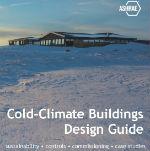 International. Buildings in Arctic and subarctic climates face not only cold-related challenges, but also remoteness, limited utilities, permafrost and extreme temperature changes. Designers must respond to these challenges, keeping occupants comfortable and minimizing the impact on the environment.
International. Buildings in Arctic and subarctic climates face not only cold-related challenges, but also remoteness, limited utilities, permafrost and extreme temperature changes. Designers must respond to these challenges, keeping occupants comfortable and minimizing the impact on the environment.
ASHRAE's recent publication "Cold Climate Building Design Guide" provides insight into the commonalities faced by designers in these climates. The idea for the guide came from a working session at the 7th International Cold Climate Design Conference held in 2012 and co-sponsored by ASHRAE, SCANVAC and REHVA.
"Harmonizing human comfort with the climatic realities of these environments is an act of balancing," said Erich Binder, who oversaw the writing of the guide. "Strategic design is key to the efficient and long-lasting construction, commissioning and operation of structures in cold climates."
A cold climate is defined by a combination of factors that create a unique set of challenges for building design. These factors include temperature, freezing rain, wind, humidity, thermal comfort, thermal enclosure/envelope, maintainability, permafrost and icy earth, and remote building locations.
The following are tips from various committee members for the design, operation, and maintenance of buildings and systems in cold weather:
What happens when air leaks through the building envelope in cold weather is similar to what happens in the cooling coil in hot and humid weather – understanding psychrometry is essential to understanding the performance of the building envelope in cold climates.
The colder the weather, the more important it is for critical equipment to be protected – you can't expect service personnel to properly repair HVAC equipment in a winter snowstorm.
In extreme climates, windblown snow takes on a sand-like consistency and requires special design techniques to prevent it from getting into HVAC air intakes.
The manual also covers design impacts for non-mechanical components of an installation such as building envelope and roof construction. For example, snow and ice sliding on a metal roof can open mechanical penetrations into the roof, as well as into the hoods installed on the outer wall.
A building envelope must consider all modes of heat loss to be truly efficient; ignoring some mode can lead to excessive heat transfer.
Freezing (frost) can be catastrophic for HVAC equipment, blocking inlet hoods, filters, coils, coils, etc.
Design cold bridges for both building structure and penetrations.
Avoid or minimize external routes for utility pipelines.
Locate air inlets and outlets avoiding snow and blockages.
Ensure that condensate pipes never freeze or clog.
Provide safe access for roof-mounted mechanical plants for all climates – frozen roofs can be a hazard.
Frank Mills, who helped write the guide, noted that the book applies to all climates that a heating season has, not just the very cold.
"We cover extremely cold climates, but we also have very useful information for any building that has heating for part of the year," he added. "This covers many climatic regions – including Europe, where I am."
In addition to considerations for HVAC system calculations and design, the chapters in this book cover sustainability, controls, building design, and commissioning, all from this different climate perspective. The book also includes an appendix with seven case studies of buildings located in extreme cold climates. These buildings are leaders in their field with respect to both efficiency and cold climate design.
The cost of the "Building Design Guide in Cold Climates" is US$90 (US$77, ASHRAE members). To order it go to www.ashrae.org/bookstore














